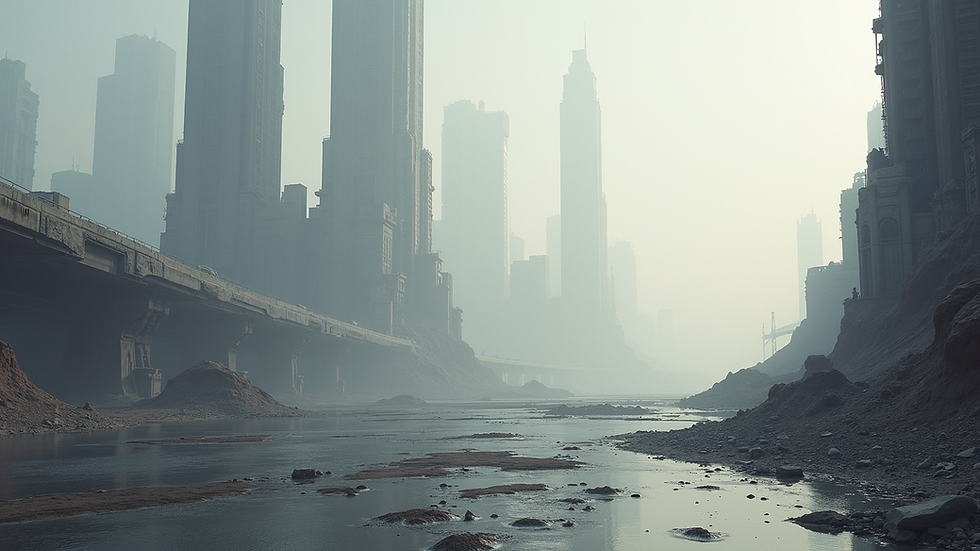Exploring Dystopian Adventures: A Dive into Futuristic Worlds
- John Calia
- Jun 5
- 3 min read
Dystopian adventures have long captured the imagination of readers and viewers alike. They transport us into futuristic worlds, where societies have often fallen into chaos, and survival becomes a game of wits. These narratives push the limits of creativity, sparking conversations about societal issues and our own world’s trajectory. In this blog post, we will explore various themes and examples within the realm of dystopian adventures that keep audiences on the edge of their seats.
The Allure of a Dystopian Adventure
Dystopian adventures offer a thrilling escape. They often portray worlds that reflect our deepest fears or aspirations. Think about "The Hunger Games" or "1984", where characters navigate through oppressive regimes or fight for survival against impossible odds. These stories often serve as a critique of real-world issues like authoritarianism, environmental degradation, and social inequality.
For readers, the thrill comes not just from the adventure but also from the reflection on our own society. We are often led to question: What would happen if the worst elements of our world intensified? How would we respond? This aspect adds an intimate layer to dystopian narratives, making them thought-provoking while providing entertainment.

Iconic Dystopian Landscapes
Each dystopian adventure features its unique landscape, shaping the narrative and influencing character arcs. These settings range from barren wastelands to bustling, oppressive metropolises. For instance, in "Mad Max: Fury Road," viewers are thrust into a harsh, post-apocalyptic desert where water and fuel dictate survival. This stark environment shapes characters’ motivations, pushing them to extremes.
Conversely, in "Blade Runner," the rain-soaked streets of a neo-noir city reflect a different type of despair, where technology overshadows humanity. These environments are more than mere backdrops; they establish the mood of the story and play a crucial role in character development.

Characters in Dystopian Adventures
Dystopian adventures are often characterized by their compelling characters. The heroes and antiheroes are typically outcasts or rebels in their societies. They face significant challenges, driving narratives forward through personal growth and resilience.
Take Katniss Everdeen from "The Hunger Games." She evolves from a survivalist in her district to a symbol of hope and resistance. Her journey encapsulates the spirit of resilience and the fight against injustice. Additionally, characters like Winston Smith in "1984" highlight the struggle against oppressive governmental control. The depth of these characters often resonates with readers, making their stories relatable and impactful.
Imagining ourselves in their shoes, we see reflections of our values and struggles, adding to the emotional weight of the story.

Thematic Elements in Dystopian Adventure
Themes in dystopian adventures dive deep into the human experience. Common elements include survival, rebellion, morality, and the impact of technology on society. These stories often provoke discussions about ethics—what constitutes right or wrong in a chaotic world?
For example, "The Giver" explores memory and emotion in a society that has sacrificed individuality for homogeneity. This narrative forces us to confront the balance between personal freedom and societal order. Additionally, themes of environmentalism resonate in many dystopian tales, as seen in "Snowpiercer," where climate change has rendered the world uninhabitable. The idea of scarcity and resource management becomes paramount.
These thematic confrontations offer readers a lens to view their world critically, making dystopian adventures more than just thrilling tales; they are commentary on our present and potential futures.
Recommendations for Dystopian Adventure Lovers
If you’re intrigued by dystopian adventures and looking for something new to read or watch, consider exploring influential science fiction books that delve into these themes. Titles like "Fahrenheit 451," "Station Eleven," and "The Handmaid's Tale" offer unique perspectives on society's multifaceted challenges.
For movies, “Children of Men” and “The Matrix” showcase profound philosophical inquiries within dystopian settings, accompanied by gripping narratives. Documentaries focusing on climate change or social issues can also provide real-world context to these fictional portrayals, enhancing your understanding of dystopian themes.
The Future of Dystopian Adventures
As we look toward the future, the landscape of dystopian adventures continues to evolve. The rise of virtual reality and interactive storytelling presents new canvases for exploring dystopian themes. These advancements allow for immersive experiences where audiences can engage with the narrative actively.
Moreover, current global issues, such as climate change and political unrest, inspire creators to re-imagine dystopian worlds that resonate with contemporary audiences. As we grapple with these challenges, we can expect to see more stories that not only entertain but also provoke thought and inspire action.
Dystopian adventures will remain a vital genre, encouraging reflection on humanity's journey. Through the lens of harsh realities, they provide insights into resilience, hope, and the continuous struggle for a better tomorrow.
In exploring these worlds, we may not only discover new narratives but also uncover the strength within ourselves to confront the dystopian elements of our reality.






Comments